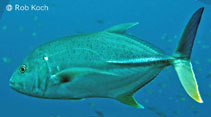| Family: |
Carangidae (Jacks and pompanos), subfamily: Caranginae |
| Max. size: |
88 cm TL (male/unsexed); max.weight: 6,400.0 g |
| Environment: |
reef-associated; brackish; marine; depth range 1 - 50 m, non-migratory |
| Distribution: |
Indo-Pacific: Zanzibar, Tanzania and South Africa to Caroline and Marquesan islands, north to the Ryukyu Islands, south to Australia. |
| Diagnosis: |
Dorsal spines (total): 9-9; Dorsal soft rays (total): 21-23; Anal spines: 3-3; Anal soft rays: 16-19. Brassy to yellowish green dorsally, shading to silvery on side with scattered dark spots (becoming more numerous with age), conspicuous silvery white spot just behind upper rear edge of opercle, dusky upper caudal fin lobe, and bright yellow to dusky lower lobe with narrow white border (Ref. 90102, Ref. 48635). Body oblong and compressed; dorsal profile moderately convex to second dorsal fin, ventral profile slightly convex. Breast scaleless ventrally, usually with small patch of prepelvic scales. Adipose eyelid weakly developed. (Ref. 90102) |
| Biology: |
Inhabit lagoon and seaward reefs, occasionally entering rivers. Juveniles found in estuaries. Swims high over bottom (Ref. 48635). Solitary or in schools (Ref. 90102). Feed primarily on fishes. Excellent food fish (Ref. 12484). |
| IUCN Red List Status: |
Least Concern (LC); Date assessed: 09 March 2015 Ref. (130435)
|
| Threat to humans: |
harmless |
Source and more info: www.fishbase.org. For personal, classroom, and other internal use only. Not for publication.
